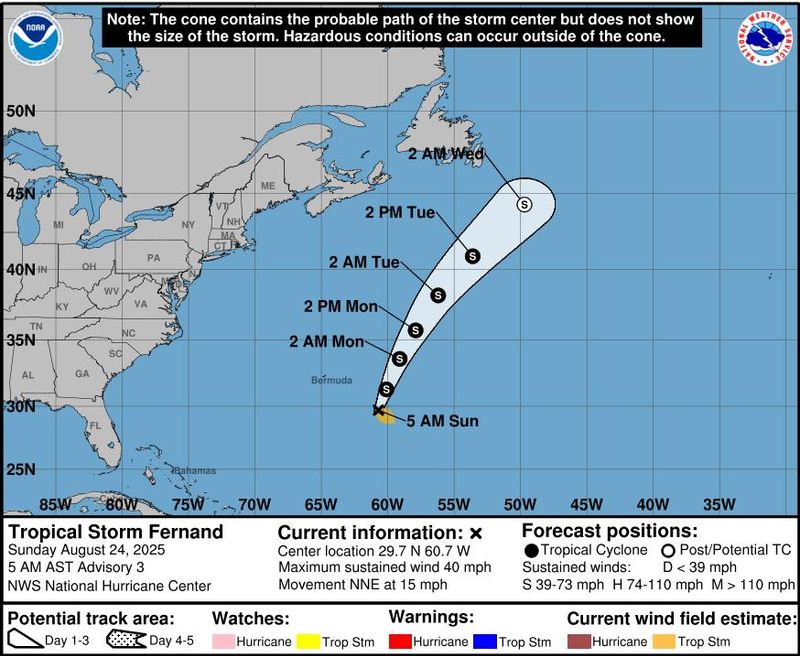
Tropical Storm Fernand has changed little overnight since it formed in the Atlantic on Saturday, Aug. 23, according to the latest forecasts from the National Hurricane Center.
It's the sixth named storm of the Atlantic hurricane season, popping up in the southwestern Atlantic right as the monster Category 5 Hurricane Erin moved out to sea.
The storm was roughly 291 miles east of Bermuda, as of the National Hurricane Center's 11 a.m. ET update on Sunday, Aug. 24. The Center's experts expect it will continue to pass "well east" of the Caribbean archipelago and head toward the open waters of the subtropical North Atlantic, following predictions made the day prior.
Maximum sustained winds were near 40 mph with higher gusts early Aug. 24, forecasters noted, with the system expected to strengthen a bit over the next 48 hours, though a weakening trend is expected by late Tuesday, Aug. 26.
Forecasts do not describe the system as having any major impact on the United States mainland.
Along with Tropical Storm Fernand, the National Hurricane Center is also tracking a disturbance in the Atlantic. The disturbance, which is associated with showers and thunderstorms, was approximately 200 miles east of the Windward Islands as of 8 a.m. ET on Sunday, Aug. 24. The Center's forecasters say there is a 40% chance of it forming into a cyclone over the next week, and is expected to reach the Central Caribbean on Tuesday, Aug. 26.
Tropical Storm Fernand path tracker
This forecast track shows the most likely path of the center of the storm. It does not illustrate the full width of the storm or its impacts, and the center of the storm is likely to travel outside the cone up to 33% of the time.
How do hurricanes form?
Hurricanes are born in the tropics, above warm water. Clusters of thunderstorms can develop over the ocean when water temperatures exceed 80 degrees Fahrenheit. If conditions are right, the clusters swirl into a storm known as a tropical wave or tropical depression.
A tropical depression becomes a named tropical storm once its sustained wind speeds reach 39 miles per hour. When its winds reach 74 mph, the storm officially becomes a hurricane.
Prepare now for hurricanes
Delaying potentially life-saving preparations could mean waiting until it’s too late. "Get your disaster supplies while the shelves are still stocked, and get that insurance checkup early, as flood insurance requires a 30-day waiting period," NOAA recommends.
- Develop an evacuation plan: If you are at risk from hurricanes, you need an evacuation plan. Now is the time to begin planning where you would go and how you would get there.
- Assemble disaster supplies: Whether you’re evacuating or sheltering-in-place, you’re going to need supplies not just to get through the storm but for the potentially lengthy aftermath, NOAA said.
- Get an insurance checkup and document your possessions: Contact your insurance company or agent now and ask for an insurance check-up to make sure you have enough insurance to repair or even replace your home and/or belongings. Remember, home and renters insurance doesn’t cover flooding, so you’ll need a separate policy for it. Flood insurance is available through your company, agent, or the National Flood Insurance Program. Act now, as flood insurance requires a 30-day waiting period.
- Create a family communication plan: NOAA said to take the time now to write down your hurricane plan and share it with your family. Determine family meeting places, and make sure to include an out-of-town location in case of evacuation.
- Strengthen your home: Now is the time to improve your home’s ability to withstand hurricane impacts. Trim trees; install storm shutters, accordion shutters, and/or impact glass; seal outside wall openings.
Kathryn Palmer is a national trending news reporter for USA TODAY. You can reach her at kapalmer@usatoday.com and on X @KathrynPlmr.
This article originally appeared on USA TODAY: Tropical Storm Fernand moving northeast in the Atlantic. See path tracker
Reporting by Kathryn Palmer, USA TODAY / USA TODAY
USA TODAY Network via Reuters Connect

 USA TODAY National
USA TODAY National
 Daily Voice
Daily Voice The Free Press - TFP
The Free Press - TFP 11Alive
11Alive CNN Climate
CNN Climate CBS News
CBS News NOLA
NOLA The Texas Tribune
The Texas Tribune KREM 2 News
KREM 2 News Newsweek Top
Newsweek Top Daily Herald Sports
Daily Herald Sports